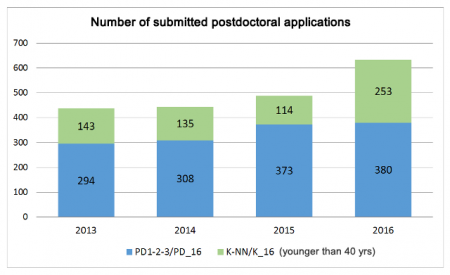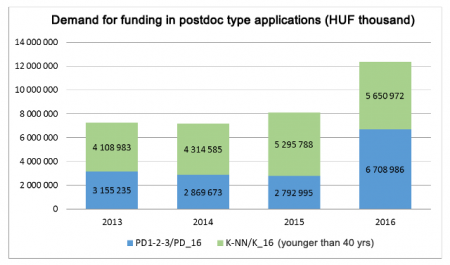This year saw significant changes in the funding system for young researchers. Previously, postdoctoral funding within the framework of the thematic research programmes of the Hungarian Scientific Research Fund (OTKA) was provided under several, overlapping titles: researchers could apply for research funding (PD1), funding for full-time employment (PD2) and even mixed funding (PD3), while thematic programmes (type K and NN) were open for young researchers. In 2016, following a well-established international approach, the NRDI Office announced the Postdoctoral Excellence Programme (PD_16) and the Researcher Initiated Thematic Programmes (K_16) as two completely separate thematic units.
The former scheme aimed to co-finance the employment costs of researchers, who have recently obtained their doctoral degree, thus helping them to stay in the research sector, join a research group led by an experienced researcher, and build their career in Hungary. Parallel to this, the other funding scheme was open for researcher initiated thematic applications, i.e. promising and internationally competitive project ideas, submitted by researchers irrespective of their age and experience, terminating the former categories of “minor” and “major” applications. This year, when evaluating the latter type of applications, evaluators, expert groups and professional panels consider researchers’ performance in relation to the number of years spent by them as researchers, so the primary focus is on the project idea and recent scientific performance has only secondary relevance. This can ensure that the representative part of funds intended for basic research are really spent on the projects of young researchers, compared to the former funding practice of OTKA which gave far better chances to more experienced researchers in respect of thematic applications.
The success of the new system is clearly shown by the fact that the number of applications submitted to this year’s calls by postdoc researchers (in PD_16, and for researchers under 40 years of age in K_16) has increased by 30% compared to the previous year in all similar types of calls combined (PD1, PD2, PD3 and thematic calls for researchers under 40 years of age).

In its call for Researcher Initiated Thematic Applications (K_16), the NRDI Office indicated that postdoctoral project ideas are also expected for the call. This gave fillip to postdoctoral researchers’ willingness to apply: the quick report about the registered applications shows that around 22% of the 1200 applications (that is 253 project ideas and research plans) were submitted by postdocs under 40 years of age. This figure is nearly 2.5 times higher than the number of applicants in the same age group last year.
As regards the amount of funding requested by young researchers, the increase is even more apparent. This year a total of more than HUF 12 billion was requested for wage-like and research costs, compared to the HUF 8 billion demand for funding last year, or the approximately HUF 7 billion demand in the years before. This increase is more than 52%.

Although this year applicants also have more available funds – the budget for research and postdoc funding from the NRDI Fund totalled HUF 7.55 billion last year and HUF 8.8 billion this year –, the increase in young researchers’ willingness to apply exceeds this 16% growth by far. Even though it is obvious that the available funds are not sufficient to satisfy all the demand, the trend is clear: postdoctoral applicants see more opportunities and thus are more ready to compete for funds in the new funding system.






